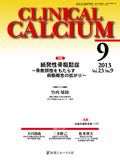Japanese
English
- 有料閲覧
- Abstract 文献概要
- 1ページ目 Look Inside
- 参考文献 Reference
生体内において免疫系と骨代謝系は,強く影響を及ぼし合うことが分かってきた。また,免疫系の不均衡,および,それが引き起こす炎症性刺激は,破骨細胞の分化誘導,骨芽細胞の分化抑制を介して,骨代謝回転の不均衡を引き起こし,続発性骨粗鬆症をはじめとした様々な病態を形成する。例えば,免疫系を活性化・遷延化するT細胞サブセットであるTh1やTh17は炎症性サイトカイン産生を介して破骨細胞を誘導し,逆に免疫抑制を担うTregはCTLA-4(cytotoxic T-lymphocyte antigen 4)を発現して破骨細胞分化を抑制する。また,炎症性サイトカインは,破骨細胞の分化誘導,骨芽細胞の分化抑制を生じ,骨代謝回転の不均衡をもたらす。逆に,免疫系や免疫関連因子を標的とした治療は,免疫異常の制御とともに,骨代謝異常の是正を促すことがある。
Bone homeostasis is maintained by a balance between bone resorption by osteoclasts and bone formation by osteoblasts. It is also regulated by immune system and its imbalance often results in pathological processes such as secondary osteoporosis. For instance, Th1 and Th17 are involved in activation of immune system and also induce maturation of monocytes to osteoclasts, which leads to osteoporosis. Contrarily, Treg(regulatory T cells)suppresses immune function, but suppresses osteoclast differentiation. Proinflammatory cytokines such as TNF cause an imbalance in bone metabolism via direct and/or indirect effects on osteoclasts. These inflammatory signals originate from the immune system, the largest source of cell-derived regulatory signals and such immunological signals to the bone results in secondary osteoporosis and bone destruction. Based on an improved understanding of immune signals, investigation of the suppression of cell functions may lead to improved understanding and better treatment of bone destruction and osteoporosis.



